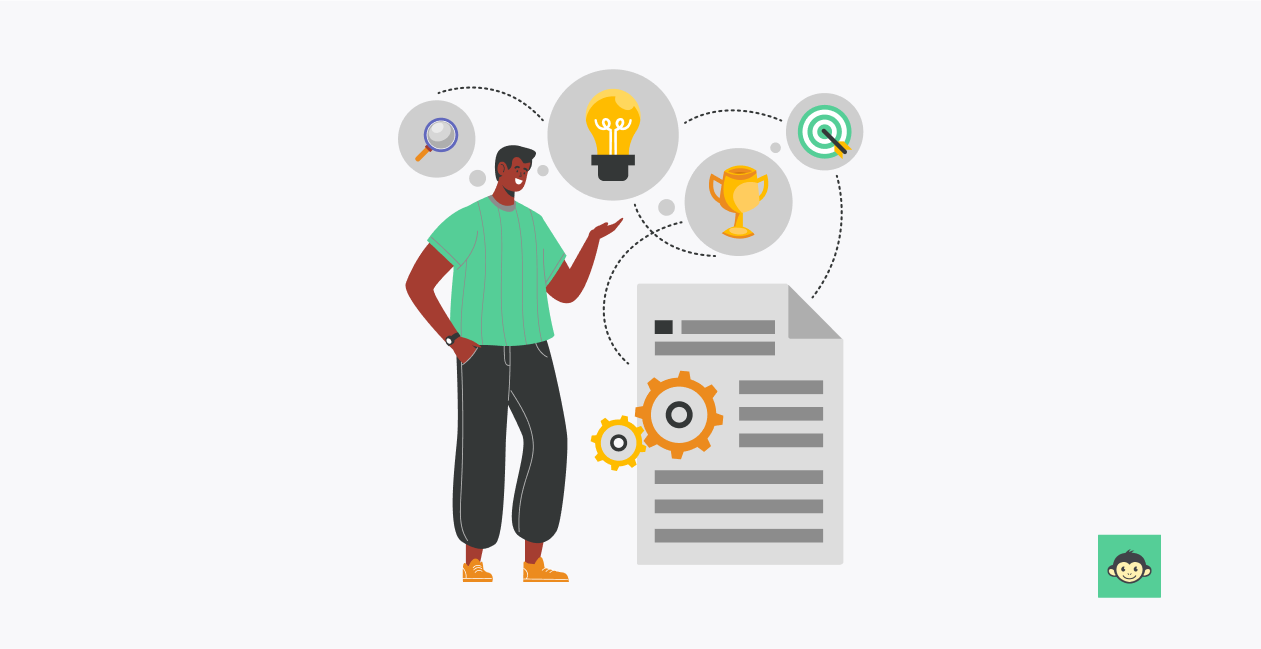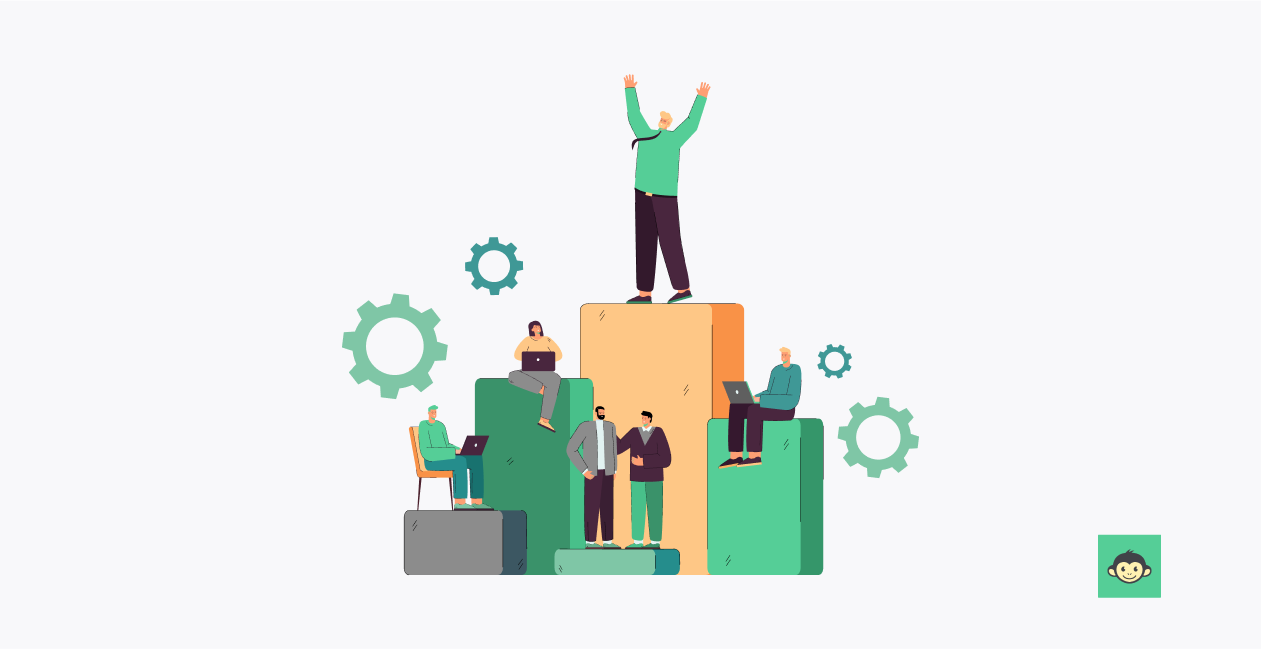15 Effective employee motivation techniques to try in 2024

Employee motivation is like tending to a garden, and you want those blooms of enthusiasm to flourish. One might even call it a happy little tree we're here to help grow. However, managing a team's success and keeping your employees motivated can be tricky. But don't worry; we're here to ensure it is as smooth as a scoop of your favorite ice cream on a hot summer day.
In this blog, we're diving headfirst into the fascinating world of employee motivation. We will explore techniques that will not only help your employees stand out but also help your business thrive like never before.
What is employee motivation?

Employee motivation is the driving force that compels your team members to give their best, day in and day out. It's the spark that ignites their passion, fuels their creativity, and keeps them makes them feel committed to their work. It's what turns "I have to go to work" into "I can't wait to go to work!"
Think of it this way: when employees are motivated, they're like eager adventurers on a thrilling quest. They're not just going through the motions; they're actively seeking ways to contribute, improve, and excel. They're engaged, inspired, and ready to conquer whatever challenges come their way.
Now, let's get practical for a moment. Motivated and engaged employees are more than just a feel-good concept. They translate into tangible benefits for your organization.
They're more productive, creative, and likely to stay with your company for the long haul. They become your brand's biggest cheerleaders, both within and outside the workplace. Plus, they can even help boost your bottom line.
But here's the kicker – motivation isn't one-size-fits-all. Just like you wouldn't expect every coffee drinker to love the same brew, you can't rely on a single motivation technique for all your employees.
It's about understanding what makes each team member tick and tailoring your approach accordingly. It's about creating an environment where they feel valued, recognized, and inspired.
In essence, employee motivation is the art and science of tapping into your team's unique career aspirations and motivations to drive exceptional performance. It's about making your workplace a space where your employees don't just fit in; they stand out and they shine.
Benefits of employee motivation in the workplace

Investing in employee motivation isn't just a perk; it's a strategic move that can lead to long-term success. Here are some of the major benefits it offers.
1) Increased productivity
Motivated employees are like well-oiled machines. They not only complete tasks efficiently but also go the extra mile to ensure high-quality work. When your team is motivated, you can expect higher levels of productivity across the board, leading to increased output and better results.
2) Improved employee retention
One of the best benefits of motivated employees is that they are more likely to stick around. They feel a sense of purpose and satisfaction in their work, reducing turnover rates. This is a win-win situation – you save on recruitment and training costs while retaining experienced, knowledgeable team members.
3) Enhanced creativity and innovation
Motivation fuels creativity. When employees are inspired and engaged, they're more likely to think outside the box, propose innovative solutions, and take calculated risks. This creative energy can lead to breakthrough ideas, positive outcomes, and a competitive edge for your organization.
4) Better employee health and well-being
A motivated workforce tends to be healthier and happier. They experience less stress, better mental health, and a higher overall sense of well-being. This not only contributes to a more positive workplace culture but also reduces absenteeism and healthcare costs.
5) Positive company culture and reputation
Motivated employees are enthusiastic brand ambassadors. They speak highly of your own company's mission, both within and outside the workplace. This positive word-of-mouth not only improves your company's reputation but can also attract top talent who want to be a part of your dynamic and motivating work environment.
6) Reduced conflict and stress
A motivated workforce experiences fewer conflicts and less stress in the workplace. Employees are more likely to collaborate effectively, communicate openly, and resolve differences constructively, creating a harmonious work environment conducive to productivity and well-being.
7) Higher profitability
Ultimately, investing in employee motivation leads to higher profitability for the organization. Motivated employees drive productivity, innovation, customer satisfaction, and employee retention, all of which contribute to improved financial performance and sustained competitive advantage.
Types of motivational techniques at work

Here are the top 5 techniques that can help motivate employees and boost employee engagement in the workplace:
1) Recognition and rewards
- Employee of the month: Recognizing outstanding performance on a monthly basis can boost morale and motivation.
- Performance bonuses: Monetary rewards tied to achieving specific goals or milestones can provide a powerful incentive.
- Public acknowledgment: A simple "thank you" in a team meeting or an email recognizing a job well done can go a long way in motivating employees.
2) Professional development
- Training and skill enhancement: Providing opportunities for employees to learn new skills or advance their knowledge can be highly motivating.
- Career path planning: Offering a clear path for career growth and advancement within the organization can keep employees engaged and motivated.
3) Employee involvement and empowerment
- Autonomy: Allowing employees to make decisions and take ownership of their work fosters a sense of responsibility and motivation.
- Participation in decision-making: Involving employees in decisions that affect their work can make them feel valued and engaged.
4) Work-Life balance
- Flexible work arrangements: Offering flexible hours or remote work options can help employees balance their personal and professional lives.
- Wellness programs: Providing wellness initiatives such as fitness programs, mindfulness sessions, or mental health support can contribute to overall employee motivation and well-being.
5) Goal setting and positive feedback
- SMART goals: Setting Specific, Measurable, Achievable, Relevant, and Time-bound goals with employees can give them a clear sense of purpose and direction.
- Regular feedback: Providing constructive feedback and performance evaluations helps employees understand where they stand and how they can improve.
What are the 7 motivators for work?

Each individual has a unique combination of these motivators that drive their performance and job satisfaction. The following strategies can be tailored to motivate your employees based on their needs and preferences.
1) Autonomy: Many employees are driven by the desire for autonomy in their work. They thrive when given the freedom to make decisions, communicate effectively, set their own goals, and manage their tasks independently. Autonomy fosters a sense of ownership and responsibility, motivating individuals to excel.
2) Challenge and growth: The opportunity to tackle challenging projects and continually develop new skills is a powerful motivator. Intellectually stimulated employees who see opportunities for personal and professional growth tend to be highly motivated.
3) Purpose and meaning: A sense of purpose can be a significant motivator. When employees feel that their work contributes to a greater good or aligns with their values, they are more likely to be engaged and motivated.
4) Recognition and appreciation: Feeling valued and recognized for one's contributions is a fundamental motivator. Whether through verbal praise, awards, or promotions, acknowledgment of a job well done can boost employee morale and motivation.
5) Financial rewards: While not the sole motivator, financial incentives like bonuses, raises, and profit-sharing can provide a tangible and motivating reward for employees who seek financial security and recognition.
6) Work-life balance: Achieving a healthy work-life balance is a motivator for those who prioritize their personal lives alongside their careers. Flexible hours, remote work options, and generous vacation time can be appealing motivators.
7) Social connection: For some, strong social connections and a sense of belonging within the workplace are primary motivators. Building relationships with colleagues, feeling part of a team, and enjoying a positive work environment and culture can be highly motivating factors.
Impact of workplace motivation on employee productivity

Workplace motivation plays a pivotal role in determining the productivity levels of employees within an organization. Motivated employees are more engaged, enthusiastic, and committed to their work, resulting in higher levels of performance and productivity. Here are the key points highlighting the significance of workplace motivation on employee productivity:
- Enhanced performance: Motivated employees demonstrate higher levels of performance as they are driven to achieve their goals and exceed expectations. They exhibit greater focus, initiative, and persistence in completing tasks, leading to improved overall productivity within the organization.
- Increased job satisfaction: Motivated employees tend to experience higher levels of job satisfaction, as they derive a sense of fulfillment and purpose from their work. This satisfaction translates into greater commitment and loyalty to the organization, reducing turnover rates and fostering a positive work environment.
- Effective leadership: Motivated employees respond positively to effective leadership, fostering trust, communication, and empowerment. Leaders who inspire and motivate their teams create an environment conducive to high performance and productivity. They provide guidance, support, and recognition, empowering employees to reach their full potential and contribute to the organization's success.
- Optimized resource utilization: Motivated employees are efficient in utilizing resources effectively to accomplish their objectives. They exhibit a strong work ethic, time management skills, and attention to detail, minimizing waste and maximizing output. Such optimized resource utilization enhances operational efficiency and contributes to the organization's bottom line.
- Career development: Motivated employees are eager to develop their skills and advance in their careers. Organizations that invest in employee development programs and opportunities for growth tend to experience higher levels of motivation and productivity. Providing avenues for advancement encourages employees to stay engaged and committed to their professional development and the organization's success.
- Adaptability to change: Motivated employees are better equipped to adapt to changes in the workplace environment. They demonstrate resilience and flexibility in the face of challenges or transitions, maintaining focus and productivity amidst uncertainty. A motivated workforce embraces change as an opportunity for growth and innovation, driving organizational agility and competitiveness in dynamic markets.
- Customer satisfaction: Motivated employees are more likely to deliver exceptional customer service and satisfaction. Their enthusiasm and dedication to their work translate into positive interactions with customers, leading to increased customer loyalty and retention. Satisfied customers contribute to the organization's success and profitability, highlighting the importance of workplace motivation in driving overall business outcomes.
What are the 3 major approaches to employee motivation?
Here are the three major approaches to employee motivation:
1) Intrinsic motivation
Intrinsic motivation focuses on tapping into employees' inner drives and desires. It centers around finding meaning and satisfaction in the work itself. Key strategies include:
- Encouraging autonomy and self-direction in tasks.
- Providing opportunities for skill development and personal growth.
- Creating a work environment that fosters a sense of purpose and accomplishment.
2) Extrinsic motivation
Extrinsic motivation relies on external rewards and incentives as ways to motivate employees and encourage performance and engagement. It involves offering tangible rewards or recognition for achieving specific goals. Effective techniques include:
- Monetary rewards like bonuses and raises.
- Recognition through awards, certificates, or public acknowledgment.
- Competitive incentives, such as contests and performance-based promotions.
3) Hybrid approach (integrated motivation)
The hybrid approach combines elements of both intrinsic and extrinsic motivation to create a well-rounded motivational strategy. It recognizes that different former employees need and have varying motivational triggers and aims to cater to a diverse workforce. Strategies may include:
- Setting clear and challenging goals (extrinsic) while allowing employees autonomy in how they achieve them (intrinsic).
- Offering financial rewards (extrinsic) for outstanding performance while fostering a sense of purpose and meaning in the work (intrinsic).
- Combining social recognition (extrinsic) with opportunities for skill development and growth (intrinsic).
Top 15 employee motivation techniques to try in 2024

Here are the 15 best employee motivation techniques and strategies to consider implementing in 2024. They will keep employees motivated and ensure it's not just a temporary thing.
- Peer recognition: Encourage colleagues to recognize and celebrate each other's accomplishments, fostering a culture of appreciation.
- Flexible work arrangements: Offer options like remote work or flexible hours to promote work-life balance and cater to individual needs.
- Professional development plans: Create personalized development paths and opportunities for skill enhancement.
- Wellness programs: Implement wellness initiatives, including fitness challenges, mental health support, and wellness workshops.
- Clear communication: Maintain open, transparent communication channels to keep employees informed and engaged.
- Purposeful goal setting: Collaboratively set SMART goals (Specific, Measurable, Achievable, Relevant, Time-bound) with employees to provide clear direction.
- Feedback culture: Establish regular feedback loops to provide constructive input and encourage continuous improvement.
- Empowerment: Give employees decision-making authority over their tasks and projects, promoting a sense of ownership.
- Team-building activities: Organize team-building events and activities to foster strong social connections and a positive work culture.
- Innovation challenges: Encourage employees to propose and work on innovative projects or solutions.
- Flexible benefits: Offer a customizable benefits package, allowing employees to select perks that suit their needs.
- Personalized recognition: Tailor recognition and rewards to match individual preferences, such as extra time off or unique experiences.
- Leadership development: Invest in leadership training and mentorship programs to help employees progress in their careers.
- Gamification: Introduce gamified elements into the workplace to make routine tasks more engaging and rewarding.
- Community engagement: Promote community involvement and volunteering opportunities to instill a sense of purpose and corporate social responsibility.
Employee motivation techniques examples to get inspired from

Here are two real-life employee motivation techniques that have proven successful for major companies. It can help you gauge how keeping employees motivated can sometimes be so simple.
1) Salesforce's "Ohana" culture:
Salesforce, a global CRM software company, has a unique approach to employee motivation through its "Ohana" culture. Ohana, a Hawaiian word for family, emphasizes creating a sense of belonging and inclusivity within the organization. Salesforce offers several employee motivation strategies and techniques within their culture, including:
- Employees are encouraged to participate in volunteer work during paid time off.
- Salesforce donates a significant portion of its profits to charitable causes, aligning employees with a higher purpose.
- The company invests heavily in employee development and offers various learning resources, motivating employees to grow both personally and professionally.
Salesforce's Ohana culture focuses on the well-being of employees, their connection to the community, and their ability to make a positive impact, making it a powerful motivation technique.
2) Google's "20% Time" policy:
Google, the tech giant known for innovation, encourages its employees to spend 20% of their work time on projects of their choice unrelated to their core responsibilities. This motivation technique has led to numerous groundbreaking innovations, including Gmail and Google News. Here's how it works:
- Employees are given the freedom to pursue their passion projects, sparking creativity and motivation.
- Google supports these projects with resources and mentorship.
- Successful projects often result in recognition and career advancement.
Google's "20% Time" policy demonstrates how granting employees autonomy to explore their interests and contribute to innovation can be a powerful motivator, fostering a culture of continuous creativity and entrepreneurial spirit.
Conclusion
Employee motivation and engagement is the heartbeat of a thriving workplace. From recognizing the unique aspirations of your team members to implementing creative and personalized strategies, the journey to a motivated workforce is both exciting and rewarding.
By embracing a combination of intrinsic and extrinsic motivators and staying attuned to the evolving needs of your employees, you can transform your workplace into a hub of inspiration, productivity, and success.
Keep experimenting with new techniques, learn from real-life success stories, and adapt to the changing dynamics of the modern workplace. In doing so, you'll unlock your team's full potential and create a workplace where everyone truly stands out and shines.
FAQs
1. How to motivate employees as a manager examples?
As a manager, motivation begins with recognition and praise for achievements, offering growth opportunities through training and development programs. Effective communication fosters a positive work environment, while setting clear expectations ensures everyone understands their role. Team support is vital, encouraging collaboration and camaraderie. Providing regular feedback and constructive criticism helps employees grow professionally, contributing to their motivation and engagement.
2. What employee motivator tends to produce the best professional results?
Intrinsic motivators such as meaningful work, opportunities for personal growth and development, and autonomy tend to yield the best professional outcomes. Feeling valued and appreciated for contributions, along with a supportive work environment, also play significant roles. Ultimately, a sense of achievement and fulfillment in tasks drives employees to excel, leading to sustained engagement and high-quality performance.
3. How can managers foster a sense of purpose among employees?
Managers play a crucial role in fostering a sense of purpose among employees. Clearly communicating the organization's mission and values helps employees understand the broader purpose behind their work. Aligning individual goals with the organization's objectives demonstrates how each employee contributes to the overall mission. Providing opportunities for employees to work on meaningful projects that align with their values and interests reinforces their sense of purpose.
4. What role does employee recognition play in motivation?
Employee recognition plays a crucial role in motivation for several reasons. Firstly, it reinforces desired behaviors and outcomes by acknowledging employees' contributions and achievements. This positive reinforcement boosts morale and job satisfaction, encouraging employees to continue performing at their best. Moreover, recognition increases employee engagement and loyalty, as employees feel valued and appreciated for their efforts.
5. How can managers support employee well-being and motivation during challenging times?
Supporting employee well-being and motivation during challenging times requires proactive measures from managers. Firstly, providing clear communication and updates on the situation helps alleviate uncertainty and anxiety among employees. Offering flexible work arrangements, such as remote work or adjusted schedules, accommodates individual needs and promotes work-life balance. Recognizing and celebrating resilience and perseverance during difficult times boosts morale and motivation.



